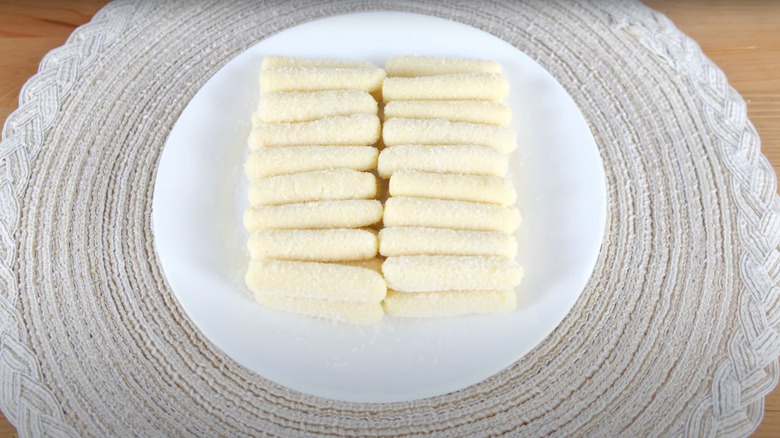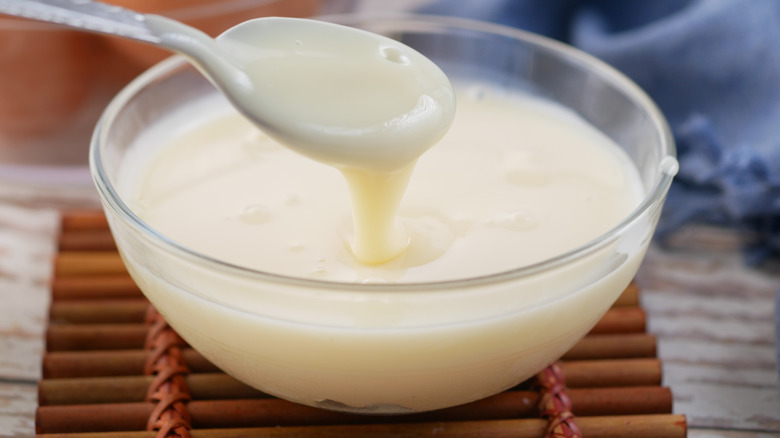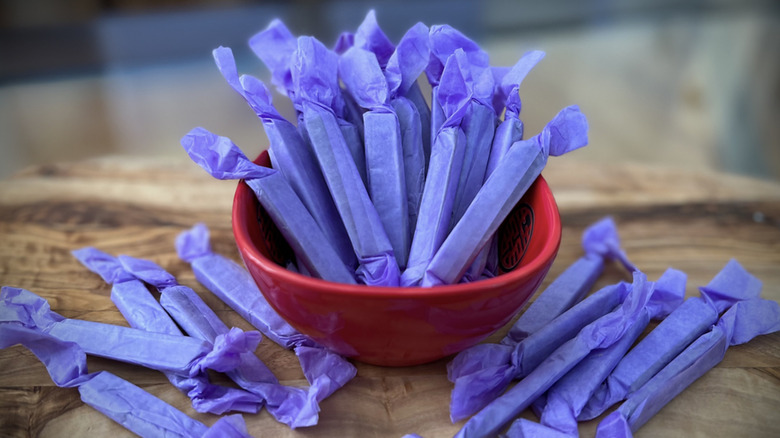The No-Bake Shortcut For Luscious Filipino Milk Candy
As if creamy sweet Filipino milk candy isn't mesmerizing enough on its own, the slim finger-like tubes come artfully draped in fanciful rainbow-hued coverings. Also known as pastillas de leche, the candies showcase culinary art in the expertly crafted recipe and the handmade pabalat wrappers. It's a candymaker's dreamscape, in spite of the extraordinary love-labor involved.
If only there were a shortcut to making Filipino milk candies, right? Fortunately, for those of us with bigger dreams than time allows, there is. Rather than simmering milk on the stovetop for hours on end, there's a simplified no-bake method that opens a realistic window for home kitchen chefs. It involves no heat, no pot-stirring, and no fresh milk.
Instead, you'll be using powdered whole milk, salt, and sweetened condensed milk. That's the familiar thick, sweet, canned milk you'll find in the baking section of most supermarkets. It's also an integral ingredient in many sweet, summery drinks, including Thai iced coffee and Brazilian lemonade.
The no-bake method may be easy, but there's still an art in forming and cutting the dough –- and then there are those crinkly colored wrappers to consider.
Making no-bake Filipino milk candy
The no-bake shortcut for making Filipino milk candies came from Filipino chef Abi Balingit, shared in her cookbook titled "Mayumu." The word translates from Kapampangan into English as "sweet," a fitting niche for the velvety indulgent pastilles. Here's how to put her technique to work in your own kitchen.
It may take some sleuthing to find whole milk powder made from cow's milk. Avoid the nonfat version as it can give a mealy texture that falls apart when forming the candies. And goat milk powder is just too far from the beloved flavor of traditional Filipino milk candy. Try Asian markets, specialty kitchen stores, or order it online. It's far easier to locate than the original carabao milk used in traditional pastillas de leche, which requires milking a water buffalo.
Once you have a coveted stock of whole milk powder, you'll add a pinch of salt, and then pour in some lusciously thick condensed milk. Some recipes suggest tossing in some citrus zest to balance the sweetness. Stir until you've created a soft dough, and then knead until it's sturdy enough to create the iconic log-like shapes of pastillas. That means long and lightly flattened, about half an inch wide and two to three inches long.
Then gently roll each piece in sugar, and there you have it –– a simple way to make a modern version of the elegant pastillas de leche Filipino milk candies.
The art of pabalat candy wrapping
Wrapping those delectable Filipino milk candies takes a light touch and creative spirit. The art of pabalat, which comes from a word meaning "skin" or "cover" in Tagalog, refers to the technique of hand-crafting the wrappers.
The art form is closely tied to the San Miguel region of the Philippines — where skilled paper artists traditionally employ small scissors to snip precise patterns into Japanese art papers. If you can get your hands on these papers, you might want to unwrap the pastillas very carefully and save the collectible designs, which can include tiny flowers, birds, and regional dancing figures.
The increasingly common mainstream way of enclosing the pastillas is to use vividly colored cellophane, tissue papers, or commercially available printed pastillas wrappers. If making your own milk candies, gather some friends or family members for a sweets-wrapping party.
When it's time to cover those lovingly made milk candies, cut a five- to six-inch square of your chosen paper, depending on the candy size. Then just place a formed pastillas in a bottom corner and roll upward, diagonally, until the candy is completely covered. You'll have two ends that can be twisted, tied, or tucked inward.
You've now mastered new culinary and paper art forms –– and created a showcase collection of deliciousness to enjoy.



